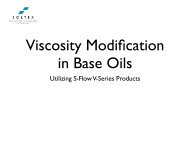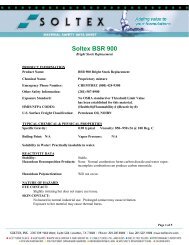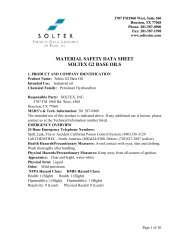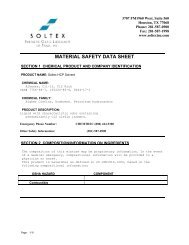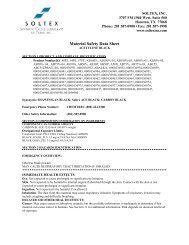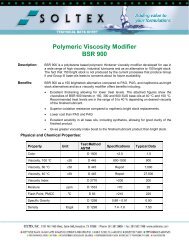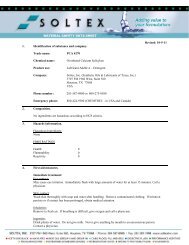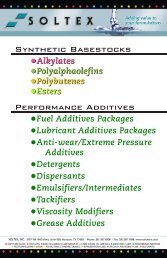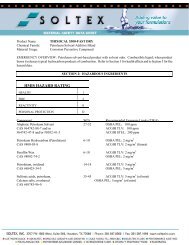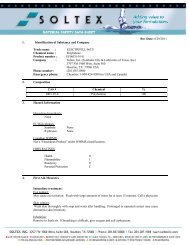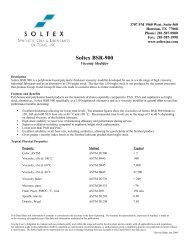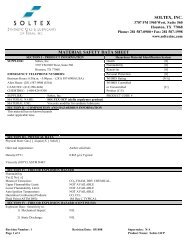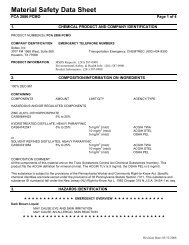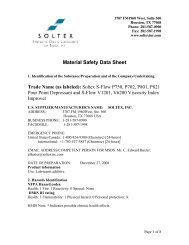Nytro 11 GBX-US Transformer Oil - Soltex
Nytro 11 GBX-US Transformer Oil - Soltex
Nytro 11 GBX-US Transformer Oil - Soltex
Create successful ePaper yourself
Turn your PDF publications into a flip-book with our unique Google optimized e-Paper software.
<strong>Nytro</strong> <strong>11</strong> <strong>GBX</strong>-<strong>US</strong> <strong>Transformer</strong> <strong>Oil</strong><br />
1. Identification of the Substance/Preparation and the Company/Undertaking<br />
Product Name: NYTRO <strong>11</strong> <strong>GBX</strong>-<strong>US</strong> TRANSFORMER OIL<br />
Product Type: INSULATING OIL<br />
Supplier: SOLTEX, INC.<br />
3707 FM1960 WEST, SUITE 560<br />
HO<strong>US</strong>TON, TX 77068<br />
<strong>US</strong>A<br />
Emergency Phone Number: CHEMTREC (800) 424-9300<br />
Other Safety Information: (281) 587-0900<br />
2. Hazards identification<br />
- Classification: No classification needed according to 67/548/EC and 1999/45/EC.<br />
- Human Health: Inhalation of vapors and/or mists might irritate respiratory tract.<br />
- Prolonged skin contact will cause defatting and possible irritation.<br />
- Eye contact might cause irritation.<br />
- Environment: Slow biodegradation, the product will remain for long time in the environment. Risk for<br />
contamination of earth, soil and water.<br />
- Physical and chemical hazard: At elevated temperatures flammable vapors and decomposition<br />
products will be released. Risk for slippery floors if spilled out.<br />
3. Composition/Information of Ingredients<br />
Chemical Name CAS-No. EC-No Weight-%<br />
Hyrdotreated Light Naphthenic Distillate 64742-53-6 265-156-6 60<br />
Hydrotreated Middle Naphthenic 64742-46-7 265-148-2 0 - 40<br />
Distillate<br />
Solvent-dewaxed Light Paraffinic 64742-56-9 265-159-2 0 - 40<br />
2,6-ditertiary Butyl-4-Methyl Phenol 128-37-0 204-881-4 < 0.3<br />
4. First Aid Measures<br />
General advice:<br />
- Inhalation: inhalation of mists, fumes, or vapors can occur causing irritation, move to fresh air. If the<br />
symptoms persist, obtain medical advice.<br />
- Skin contact: Remove immediately adhering matter and wash off with soap and plenty of water.<br />
- Eye contact: Rinse with plenty of water.<br />
- Ingestion: Clean mouth with water. Obtain medical advice if a large amount has been swallowed. Do<br />
not induce vomiting.<br />
Page 1 of 5
5. Fire-fighting Measures<br />
Suitable extinguishing media:<br />
- Extinguish preferably with dry chemical, carbon dioxide (CO2), or foam. Water-spray/mist may be used.<br />
Extinguishing media which must not be used for safety reasons:<br />
- Water jet, unless used by authorized people.(Stain risk caused by combustion).<br />
6. Accidental Release Measures<br />
- Personal precautions: Suitable protection equipment should be used. In case of large spillage, the<br />
cleaning procedure should be carried out using suitable protective clothing such as overalls, gloves, and<br />
boots. Remove contaminated clothes as soon as possible. Smaller spillage can be wiped up with paper<br />
cloths, using protective gloves.<br />
- Environmental precautions: Prevent spills from spreading to drains, sewers, watercourses, and soil.<br />
Contact local safety authorities.<br />
- Methods for cleaning up: Absorb leaking product with sand, earth, or other suitable inert material and<br />
collect. Dispose according to section 13.<br />
7. Handling and Storage<br />
- Handling: Handle in accordance with good industrial hygiene and safety practices. If handled at<br />
elevated temperatures or with high-speed mechanical equipment, vapors or mists might be released<br />
and require a well-ventilated workplace.<br />
- Storage: Store at ambient temperature or with lowest necessary heating as handling requires.<br />
8. Exposure Controls/Personal Protection<br />
Control parameters: Exposure via the air and normal handling.<br />
- Chemical name: Mineral oil.<br />
- Short-term value: 5 mg/m3. TLV-TWA 8 hours ACGIH (1998).<br />
- Engineering measures to reduce exposure: Mechanical ventilation and local exhaust will reduce<br />
exposure via the air. Use oil resistant material in construction of handling equipment. Store under<br />
recommended conditions and if heated, temperature control equipment should be used to avoid<br />
overheating.<br />
Personal protection equipment:<br />
- Respiratory protection: If the product is heated under manual handling, use suitable mask with filter<br />
A1P2 or A2P2. Handling in automatic production lines, with exhaust or ventilation, will not require mask.<br />
- Hand protection: Wear oil-resistant protective gloves if there is a risk of repeated skin contact. Suitable<br />
gloves are neoprene, nitrile, acrylnitrilebutadiene, rubber, or PVC. Take notice of CEN 420:94, CEN<br />
374:1-3:94 and CEN 388:94.<br />
- Eye protection: Wear safety goggles/safe shield if splashes may occur.<br />
- Skin and body protection: Wear protective clothing if there is a risk of skin contact and change them<br />
frequently, or when contaminated.<br />
- Hygienic measures: Act in accordance with good industrial hygiene and safety practice.<br />
Page 2 of 5
9. Physical and Chemical Properties<br />
Form:<br />
Viscous liquid<br />
Color:<br />
250°C<br />
Density 15°C:<br />
882 kg/m3<br />
Flash point, PM: 150°C<br />
Auto ignition temp.:<br />
>270°C<br />
Solubility in water:<br />
Non soluble<br />
Solubility in organic solvents:<br />
Soluble<br />
Decomposition temp.:<br />
>280°C<br />
Vapor pressure at 100°C:<br />
160 Pascal<br />
Calculated partition coefficient n-octanol/water, log P ow : > 6<br />
Viscosity at 40°C:<br />
8.7 cSt<br />
pH:<br />
non relevant<br />
10. Stability and Reactivity<br />
- Stability: Stable at normal conditions. Starts to decompose above 280°C.<br />
- Avoid: Excessive heating and highly oxidizing agents.<br />
- Hazardous decomposition products: Flammable gases which might also be noxious. With air present,<br />
there is a risk for auto ignition at temperatures >270°C.<br />
<strong>11</strong>. Toxicological Information<br />
Acute toxicity:<br />
- Studies available indicate oral and dermal LD 50 s of >5 000 mg/kg which is considered as low acute<br />
toxicity.<br />
Local effects:<br />
- Inhalation: Prolonged and repeated inhalation of mist or vapor generated at elevated temperatures may<br />
irritate respiratory tract.<br />
- Oral: May cause nausea and eventually vomiting and diarrhea.<br />
- Skin contact: Prolonged or repeated exposure may lead to defatting of the skin and subsequent<br />
irritation.<br />
- Eye contact: May cause redness and transient pain.<br />
- Sensitization: Studies indicate no evidence of sensitization.<br />
Page 3 of 5
12. Ecological Information<br />
- Mobility: Low, due to low water solubility.<br />
- Persistence/degradability: The base oil is not readily biodegradable. Substances may not meet criteria<br />
for ready biodegradability. Studies indicate inherent, primary biodegradation in the range of 20-60 %<br />
based on carbon dioxide evolution.<br />
- Bio-accumulation: Base oil has Log Pow in the range >3,9->6,0.<br />
- Log Pow is used for estimating the bioaccumulation in fish. A value >3,0 indicates possible<br />
bioaccumulation. The size of the hydrocarbon molecules reduces the risk for bioaccumulation.<br />
- Ecotoxicity: Aquatic toxicity data on base oils indicate LC50 values of >1 000 mg/l, which is considered<br />
as low toxicity. Chronic toxicity studies shows no long-term hazard to the aquatic environment.<br />
13. Disposal Considerations<br />
- Residues of unused product are not regarded as hazardous waste. Residues of products/packaging<br />
must not be disposed of in the environment, but taken care of in accordance with local regulations.<br />
Emptying instructions:<br />
- Barrels and equals: Turn the barrel upside down and tilt it approximately 10° until nondripping.<br />
Nondripping is less than one drop / minute at 15 °C. The product viscosity depends on temperature, and<br />
it is important that the emptying is not done at too low of a temperature. It may be necessary to scrape<br />
out high viscous products. When the barrel is nondripping send it for recycling. If the residue volume is<br />
more than 1% send it for destruction of barrels. Empty barrels with < 1 % residue are not dangerous<br />
goods. Notify local regulations.<br />
- Bags for one way use/multiple use: Follow instructions given by the bag manufacturer. The last residues<br />
in the bag can be removed by placing the hose over the remaining residues or by lifting the bag so the<br />
product can run towards the hose.<br />
- Bottom residues: Roll up the bag towards the hose to press out the oil.<br />
- One way bags of polyethylene can be recycled or disposed of by incineration. Notify local regulations.<br />
14. Transport Information<br />
The product is not classified as hazardous goods for land, sea, and air transport according to the<br />
respective regulations (ADR, IMDG, IATA-DGR).<br />
15. Regulatory Information<br />
- Classified according to European directives on classification of hazardous substances and preparations.<br />
Not classified as hazardous. No statutory label required.<br />
- Listed in TSCA ( Toxic Substances Control Act) and EINECS.<br />
- Listed in Canadian DSL registry.<br />
Harmful<br />
- S-phrases: S 62: If swallowed, do not induce vomiting: seek medical advice immediately and show this<br />
container or label.<br />
Page 4 of 5
16. Other Information<br />
The information for labeling and ecotoxicity is according to Concawe Report No. 95/59, 98/54, 05/6 and<br />
01/54.<br />
Classified according to the Dangerous Substance Directive, 67/548/EC up to the most recent ATP, the<br />
Dangerous Preparation Directive 1999/45/EC, and the Safety Data Sheet Directive 2001/58/EC, and<br />
REACH (EC) No 1907/2006 according to transitional provisions.<br />
Classification of component with CAS no 128-37-0:<br />
- Classified as dangerous for the environment, N, according to 67/548/EC and 1999/45/EC.<br />
- R51/53: Toxic to aquatic organisms, may cause long- term effects in the aquatic environment.<br />
Component CAS no 64742-53-6 has DMSO extractible compounds according to IP 346



